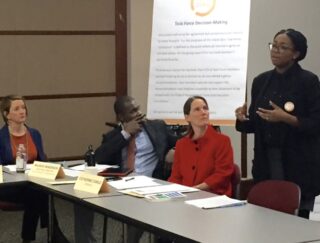
and project consultants Catherine Ciarlo and Joy Davis
with CH2MHill at the Vision Zero Task Force
meeting on February 25th.
(Photos: J. Maus/BikePortland)
Right now in New York City the Director of the Portland Bureau of Transportation Leah Treat, three of her staff (including head Traffic Engineer Steve Townsen), and a Portland Police Bureau sergeant are at the Vision Zero Cities Conference.
The summit features the major leaders in the growing traffic reform movement that is changing how America approaches street culture.
Portland officially adopted Vision Zero as a policy goal last summer; but for Treat it’s more than just another policy. It’s the one issue she’s put more personal and professional capital into than any other since taking over at PBOT nearly three years ago.
“It’s going to take a lot of aggressive measures to achieve Vision Zero. And some courageous conversations.”
— Leah Treat
To make that bold vision a reality, PBOT and Treat are spearheading a multi-agency and interdisciplinary effort that aims to do something many simply believe will never happen: the complete elimination of injuries and deaths on Portland roads by 2025.
“It’s going to take a lot of aggressive measures to achieve Vision Zero,” Treat shared at a meeting of the Vision Zero Task Force late last month. “And some courageous conversations.” It will also take money and Treat has backed up her words with a $500,000 budget request to support Vision Zero. The money will be used for an educational and outreach campaign, a new small grants program for community organizations, and some small-scale infrastructure projects.
One reason courage will be needed to eliminate road deaths is because to do so will require a lot less driving. Portland has had some success in encouraging people to walk, bike and take transit; but the vast majority of Portlanders still get in a car everyday. One reason for that is because our local politicians are much better at promoting cycling and walking than they are at actively discouraging driving.
Why is less driving such an key part of this equation? “More driving equals more dying,” Treat said twice at the recent Task Force meeting, citing a recent report from the National Highway Transportation Safety Administration.
Advertisement
PBOT has assembled a very impressive group of people around this effort. The Task Force includes top brass from the usual transportation advocacy groups; but more importantly from a lot of people and groups you don’t typically see in these discussions: Disability Rights Oregon, AAA, Elders in Action, the Asian Pacific American Network of Oregon, the Portland Fire Bureau, a traffic court judge, a transportation researcher from Portland State University, and so on. (There’s also a Technical Advisory Committee and an Executive Committee.)
And the members of the Task Force are not sitting on their hands. While I was at the meeting they were quick with questions and fully engaged in the discussion. At one point the commander of the police bureau’s traffic division and a fire bureau lieutenant disagreed openly about the impacts of marijuana use on traffic crashes.
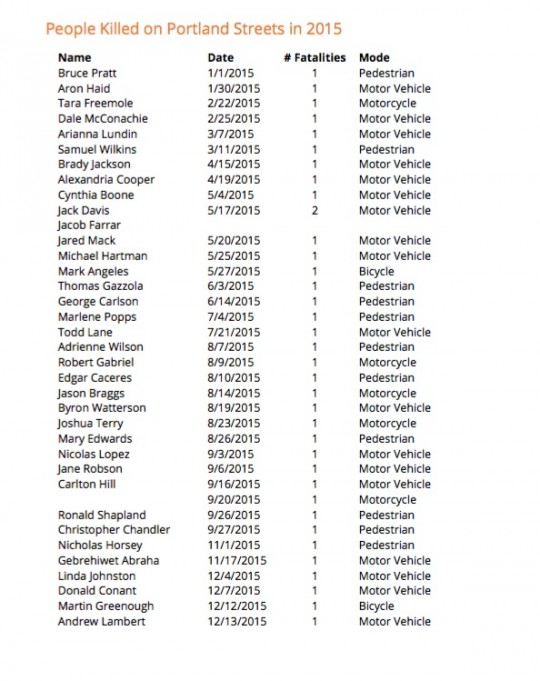
So far PBOT’s Vision Zero effort has focused on the “who” and the “where” of traffic crashes in Portland. They’ve poured over data and maps in order to start their attack with a foundation of clear knowledge about the scope of the problem. When it comes to understanding the danger risks in our current system, they looked beyond standard DMV crash data which vastly underreports biking and walking incidents. To do this they added a dataset into their analysis that takes into account road width, vehicle speeds, and so on to find out where vulnerable users are most at risk.
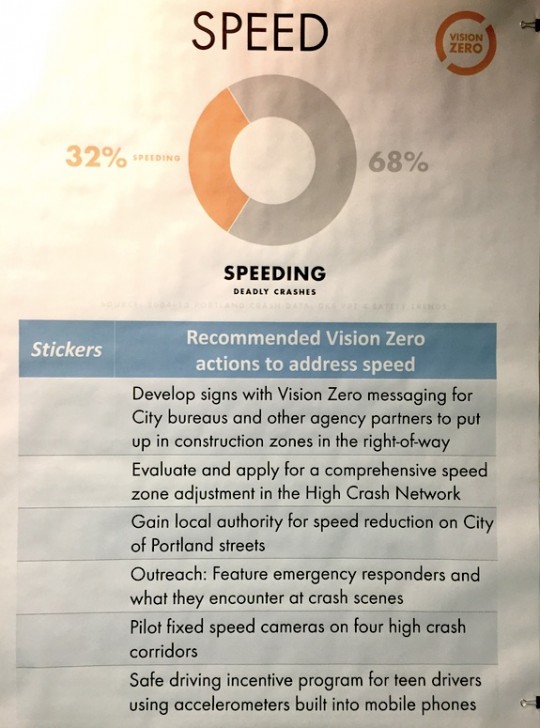
Now the work is moving toward the “what” — which policies and programs will Portland implement to make real progress toward their ambitious goal?
PBOT safety programs manager Gabriel Graff said in a presentation at the meeting that they’ll focus on four priority areas: speeding, impairment, disobeying traffic laws, and road design. Keeping with their commitment to data, PBOT backed up those focus areas with numbers: 32 percent of Portland’s fatal crashes involve speeding, 62 percent are drug and/or alcohol-related, 34 percent are from someone running a red light, and 47 percent of fatalities happened on one of Portland’s 25 most dangerous roads (a.k.a. “high crash corridors”).
PBOT had a poster board up at the meeting for each of the four focus areas. There was a list of about a dozen recommended actions and task force members were asked to place dots on the ones they supported the most.
We’ll keep you posted on Portland’s progress on this important initiative. Later this summer you’ll have a chance to get more involved with the process when PBOT hosts a series of open houses which are slated to start in June. Learn more at VisionZeroPortland.com.
— Jonathan Maus, (503) 706-8804 – jonathan@bikeportland.org
BikePortland can’t survive without subscribers. It’s just $10 per month and you can sign up in a few minutes.



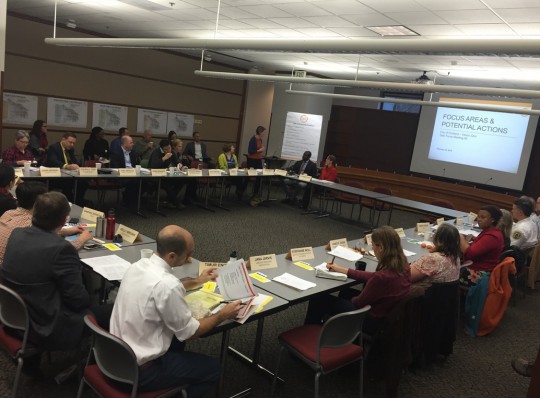
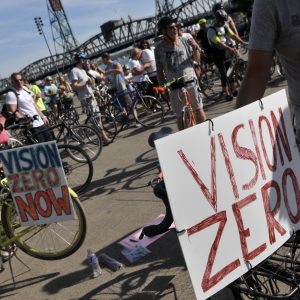



Thanks for reading.
BikePortland has served this community with independent community journalism since 2005. We rely on subscriptions from readers like you to survive. Your financial support is vital in keeping this valuable resource alive and well.
Please subscribe today to strengthen and expand our work.
First of all, using a required smart phone app to send a citation to the driver via DMV when the smart phone is in use fir communication while the phone is in a moving vehicle. Also a citation if the driver is going over 30 MPH. Now if a smart phone could detect if a driver was inebriated either alcohol of drugs. The same thing with an email to the driver’s insurance.
Another for notifying DMV an insurance when a driver is exceeding 30 MPH on city streets as shown from it’s GPS.
How would you know if the phone is being used by a driver or a passenger?
You wouldn’t be able to. That might not be a problem if we fix the law. Perhaps passengers shouldn’t be allowed to use phones in a moving car for the same reason passengers aren’t allowed to have open containers.
This goal is 9 years from now and they are only asking for $500,000?
Per year?
“… they’ll focus on four priority areas: speeding, impairment, disobeying traffic laws, and road design.”
I sure hope DISTRACTED DRIVING is in there!!!! It is utterly rampant.
[Of course it’s in there, but it would be proper to call it out as it’s own monster category.]
And we seem to have achieved a cultural shift where red-light running is the norm at the end of the signal cycle.
We need to come down HARD on these behaviors.
” … our local politicians are much better at promoting cycling and walking than they are at actively discouraging driving.”
Thanks for saying the apparently unsayable – we need to actively discourage driving.
“32 percent of Portland’s fatal crashes involve speeding”
Again I wonder what the definition of speeding is. 1 mph over?
The definition of PBOT and PPB of speeding is 10 over posted speed or 10 over the average speed whichever is faster.
I question the statistic that only 32% of crashes involve speeding, when the vast majority of drivers are speeding anytime they get a chance to. If this number is accurate (and I mean by considering anything over the speed limit as speeding), then the other 68% of crashes must be in intersections, or other low-speed areas.
32% of the crashes list speeding as the first, or only cause. it’s a nuance the consultant is looking into.
Oh, okay, that’s interesting. From that I would assume they mean ‘excessive speeding’, as in ‘speeding enough to be cited as the first or only cause of the crash’. Not just going with the flow ordinary traffic (ordinary speeding). Thanks!
Can a transcript of the entire conference please be sent to ODOT? Especially given that many of the “high crash corridors” in the city limits are on roads they control, it would seem they have a role to play.
It remains unconscionable that ODOT pledged to not install red light cameras on Powell at 26th, in front of Cleveland High School. That light gets run almost every light cycle.
I don’t care how expert they are, if they are not including distracted driving as a top priority, they don’t know jack. Studies show its a factor in more than half of collision. They may counter that it does show up on their local list of fatalities as a contributing factor, but how can you conclude that when intestigators rarely if ever check for it, or even ask the driver. Any Vision Zero program must include cell phone usage time stamp checks as part of collision investigations, and agreassive distracted driving enforcement.
More than half? Link?
There was a study on by the AAA Foundation for Traffic Safety (ironic, I know) that showed “distraction was a factor in 58 percent of all crashes studied” for teens.
Interacting with one or more passengers: 15%
Cell phone use: 12%
Looking at something in the vehicle: 10%
Looking at something outside the vehicle: 9%
Singing/moving to music: 8%
Grooming: 6%
Reaching for an object: 6%
Interesting that cell phone use is only 12% of that. So many things to be distracted by!
http://newsroom.aaa.com/2015/03/distraction-teen-crashes-even-worse-thought/
Distracted driving falls under impairment in these statistics and in the proposed actions. Of course, the crash factors studied were those that contributed to either fatal or Injury A crashes. So there are probably a larger cache of crashes with distracted driving as a factor, but those crashes may not have resulted in a fatality or Injury A (thus aren’t captured in the analysis here).
The vast majority of injury crashes are not captured in this analysis because neither PBOT or the PPB track them. If this city were serious about vision zero there would be discussion and funding dedicated to tracking all serious injuries, not just the tiny fraction coded due to ER visits.
PBOT tracks no crashes, DMV does. PPB reports to DMV if a medical transport is involve or a fatal crash, and PBOT gets preliminary fatal crash reports.
Vision Zero is not about eliminating all crashes. It is about eliminating all fatal and serious injury crashes, the kind that are most reliably reported. Vision zero cares nothing about property damage only crashes.
I am not sure why portland has street repair funding problems. From what I have seen, if they could figure out a low cost way to give tickets to all the red light runners and speeders and other traffic lawbreakers in Portland it would fund all the street repair and infrastructure investment we would need.
it is my understanding that portland only gets a fraction of that revenue and it does not really allow for much “profit”. automated ticketing would be a way to increase revenue.
The most dangerous drivers I have encountered lately seem to be really angry about the idea of anyone riding on ‘their’ roadway in anything other then a car. We need the police to start following up on aggressive divers that have been reported by licence plate. I shouldn’t have to carry a video camera to have my report taken seriously.
After listening to a traffic enforcement officer at this week’s Portland Bicycle Advisory Committee describe the procedural and legal obstacles to getting citations and REAL punishment for DUI, reckless driving, speeding, etc., it’s clear to me we have a looooong way to go. The system is clearly set up to give HUGE deference to the motorist, no matter how drunk or how many times they’ve previously been ticketed. The officer said statistically, DUI drivers only get caught roughly once every 150 time they do it! And here I’ve naively thought my multiple bike lights would keep me safe!
Much of Vision Zero goes beyond what Portland can do. This almost literally needs to come from the President on down that we’re simply not going to tolerate needless injuries and fatalities anymore and that Vision Zero is more than a slogan to toast to.
Vision Zero/Safe Systems is about attacking the problem from several directions. Legislative changes at the State level can solve many of the legal challenges, but only after legislators understand their role. The same can be said for road users, designers, law enforcement and adjudicators.
I wish they would patrol events like Blazer games for drunk drivers. Drunk drivers scream out of that place after each game and fan out across the City. I think if they visibly patrolled for a few games in a row people would get the idea and start figuring out a dd
VZ…”is more than a slogan to toast to.”
It is a…”courageous conversation.”
Right.
We’ll talk people out of being maimed and killed on our roads and streets.
Big applause to Leah Treat for making that “more driving equals more dying” statement! That’s not something most people would like to hear but that’s what we all need to acknowledge and directly address in transportation planning and policy-making. Every time you are behind the wheel, you are imposing risks to other road users.
I would very like to see other public agencies demonstrate leadership like Leah Treat at PBOT.
Hard to offer suggestions or criticism to a partial list of their efforts, but from I see above it looks mostly like an advertising campaign and it pretty much says that in the article. Not that education is a bad thing, but without dramatic efforts put into enforcement, redesign, and changes to the traffic laws it will fall short.
The biggest problem with the advertising campaign is even bad drivers and people that drive too much don’t think that that the message applies to them – everyone is their own best driver on the road. Of course they don’t drive too much – how are they going to pack a loaf of bread and gallon of milk on a cold rainy day on bicycle – you must be kidding?
If VZ is for real, where is the banning turns on reds, red light cameras, adding better lighting to marked crosswalks, adding turn signals to every turn lane, greater enforcement of parking violations and blocking intersections, mandatory VRU sentencing, lowering of speed limits (is there any reason for a speed limit greater than 25 east of the 205 and greater than 35 west of it?), extended walk cycles at traffic lights, ….etc etc.
And if it’s about driving less what about bringing back and expanding fareless square make the max free throughout the system.
GB,
The state legislature dictates the use (place and time) of camera enforcement and PBOT is the leader in its use.
Any clue how many speed limits have been reduced in the last two years? (19)
Are you aware of the standards used to set walk timing in Portland compared to other jurisdictions?
Do you know the best way to light a crosswalk? (it’s not overhead)
Protected left turns everywhere are coming, but like countdown pedestrian signals, unless the Feds fund a wholesale switch, it will take time to make the conversions.
To show that they’re serious, the city could start enforcement of ORS 811.550(17), which would improve road safety for all users by allowing clear sight lines at every intersection.
I don’t even see the word ODOT in the article. Vision Zero will be a fantasy until the agency responsible for the most dangerous roads in the city gets onboard, either voluntarily or by force. Until we as a city force Rian Windsheimer and Matt Garrett to either take responsibility for each person that dies on their roads and rethink their entire philosophy (a tall order) or resign, it’ll all be for naught.
Don’t get me wrong, I love what Leah Treat is doing, and every journey begins with the first step. But achieving zero deaths on one road just to have ODOT let the carnage continue on the next road over sounds like a recipe for disappointment.
Zero fatalities is not achievable forever, but it doesn’t mean we don’t try, or at least do our part, including as road users.
“The goal is not always meant to be reached, but to serve as a mark for our aim.” – Joseph Joubert, essayist
Road users are going to start respecting the posted speed? When and how exactly is that going to happen? Starting with police cruisers and trimet buses? Something about a pledge for city employees…
Culture change, as was done by MADD and seat belt use, takes time and multiple points of attach to achieve. Enforcement, as was done with seat belts, is one point of attack. Changing the law, as was done with BAC, is another point of attack.
Even so, the lack of knowledge about how fast things can go wrong, and what affect your speed may have on others, is information not generally known by most road users. Your first have to have a majority say ‘speeding = bad’ before you can even get to the nuance that ’30 in a 25 = very bad if you hit someone’.
Oregon should start be requiring a certificate from an accredited Driver’s Education program before allowing license testing.
“…start by…”
We don’t need a culture change for the chief of police to instruct his officers to start driving the speed limit. That would be a welcome change.